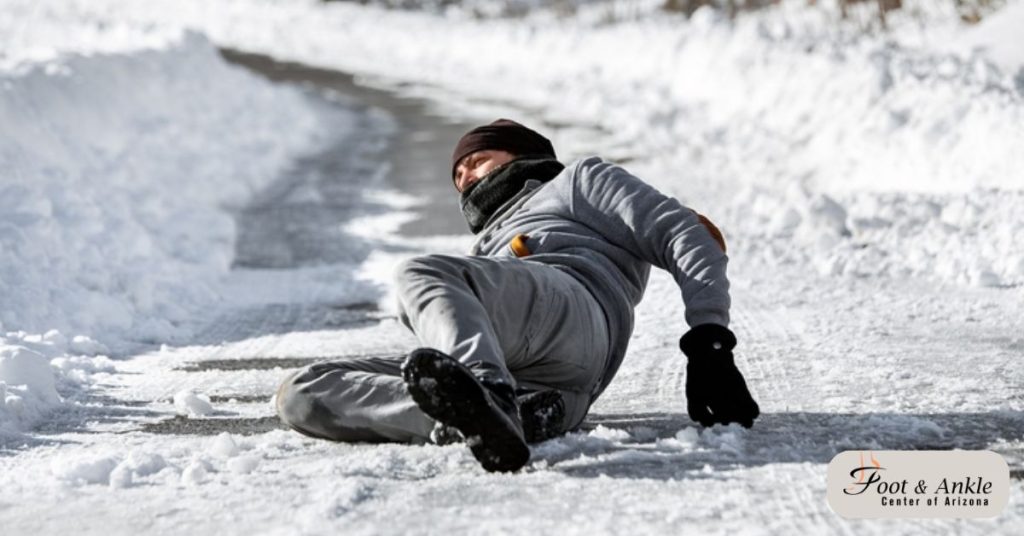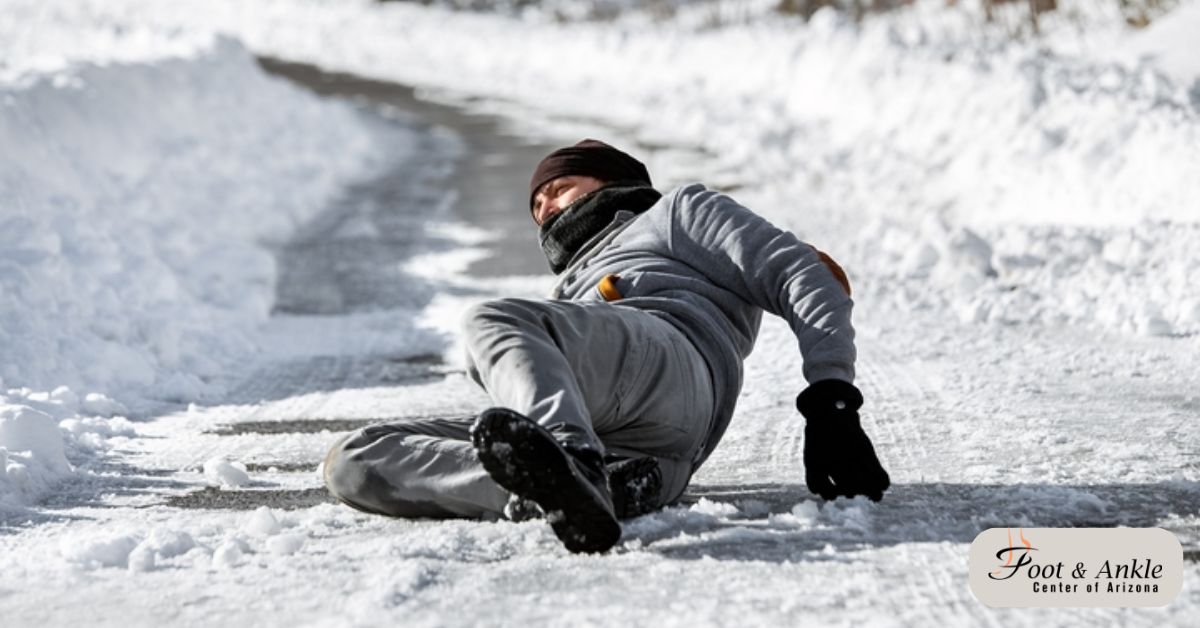Planning a holiday trip back east or heading north to the mountains for winter sports? Follow these tips from the Foot and Ankle Center of Arizona to prevent falling on icy, snowy surfaces and avoid the need for ankle treatment or bunion care due to winter mishaps.
Walking on ice can be treacherous. One moment you’re upright and the next, you’re sliding — if you’re lucky, you’ll land on a cushioned spot. If you’re unlucky, you might injure yourself and require treatment for a twisted ankle or worse. Slipping is no joke. According to the Workers Compensation Fund, slips, trips, and falls are the second leading cause of accidental deaths in the United States, surpassed only by traffic accidents. Snowy, icy sidewalks and parking lots are responsible for 80 percent of these incidents.
So, how can you safely navigate an icy path without going “thud” or “crack”? Here are some tips to keep you safe.
Be an Ice Warrior
Treat Sidewalks and Parking Lots with Caution: Even if a sidewalk or parking lot appears clear of snow, it can still have a layer of translucent ice. Always assume that any wet surface could be slippery and move cautiously. If a sidewalk looks icy, consider walking on the grass for better traction.
Choose the South Side: Whenever possible, walk on the southern side of the path. North-facing areas tend to stay icy longer.
Keep Your Hands Free: If you start to fall, you’ll need your hands to help stabilize yourself. Invest in gloves that keep your hands warm so you’re not tempted to tuck them in your pockets.
Avoid Creating Indoor Hazards: Once inside, remove your boots to prevent creating a slippery floor. Watch out for slick spots that others may have left behind.
Arm Yourself with Protection
Wear Appropriate Footwear: Invest in low, wide-heeled shoes with thick-tread soles made of rubber or neoprene composite. Avoid plastic and leather soles, which offer no traction. For extra safety, consider ice grippers that slip over your shoes or boots, available online or at sporting goods stores. Regularly remove sticking ice and snow from them to prevent additional hazards.
Use a Cane with an Ice Pick: Even if you don’t usually use a cane, one with an ice pick on the end can help you balance on slippery surfaces. These can be found online and at drugstores.
Dress for Safety: Wear a bulky coat to cushion the impact if you do fall. You can also try hip protectors, which are pads that slip into your pants or are worn as a belt. These are available online or at big box stores.
Wear Sunglasses: The white glare of snow can be blinding. Wearing sunglasses can help you see clearly and avoid slippery spots.
Carry Grit: To really avoid falling, carry a small bag of sand, grit, or non-clumping kitty litter to sprinkle on icy spots as you encounter them.
Walk This Way
Walk Like a Penguin: Spread your feet to broaden your base, making it harder to fall. Bend your knees slightly to lower your center of gravity, and extend your arms to the sides for balance.
Shuffle Slowly: If walking like a penguin isn’t for you, keep your feet about a foot apart and take small, shuffling steps. Align your feet after each step and keep your pace slow.
Take Stairs One at a Time: When navigating icy steps, test the handrail and ensure both feet are planted on each step before moving to the next one.
Fall Like a Pro: If you’re about to fall, lean forward to protect your head and spine. Try to fall on your thigh, hip, and shoulder, rather than on your arms, knees, wrists, or spine. Relax your muscles as you fall to reduce the risk of injury.
By following these tips from the Foot and Ankle Center of Arizona, you can enjoy your winter activities safely and avoid the need for ankle treatment, bunion care, or other medical interventions due to winter falls. Stay safe and have a wonderful winter season!





